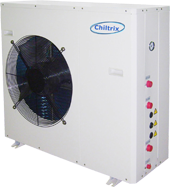Automatic Heating Reset CurveAll air to water heat pumps used in heating mode work more efficiently and have higher capacity when the heating loop operating temperature is lower, including the AHRI-Certifed record-setting Chiltrix CX34. That's because when the loop operating temperature is lower, there is less "lift" or delta between outdoor ambient and the loop operating temperature, resulting in less work for the compressor to do and this produces gains in both efficiency and capacity.
Accordingly, indoor equipment, fan coils, air handlers, or radiant installations, should be sized to run at the most efficient (coolest possible) heating temperature. A cooler supply temperature means you will use a slightly larger fan coil, air handler, or more radiant material. As mentioned, with fan coils or air handlers, when using a lower operating temperature, just use a larger size unit.
*From an efficiency or capacity standpoint, increasing the indoor load handling capacity is vastly preferable to increasing the operating temperature of an air to water heat pump*
|
|---|
|

Click to Watch ABC News Video (2:35)

Most people in the radiant heating industry will tell you that outdoor reset is used to get more BTU delivery from the radiant system on a day when the radiant system can't deliver enough BTUs to keep up with the load, and they use outdoor reset to crank up the radiant heat operating temperature to 120F, or higher.
While that's true, it's also true that the best designed air to water radiant systems will be able to deliver what's needed at a fairly low temperature even with severe outdoor design conditions.
So if you can't get enough radiant capacity into the floor, then if possible, add some to the walls or ceiling. Note that radiant heat works just as well from the ceiling or walls as it does from a floor. And in some cases, it works better from the ceiling.
With a fossil fuel burning boiler, it doesn't matter. Gas, propane, and oil efficiency does not vary with outdoor temperature or the amount of lift. But that's not the case with a heat pump.
Here's why:
 The above is the Carnot efficiency equation for a heat pump. The numerator Q¹(T¹- T²) ) tells the story of how lift affects efficiency.
The above is the Carnot efficiency equation for a heat pump. The numerator Q¹(T¹- T²) ) tells the story of how lift affects efficiency.
For a real-world example, at 0F outdoor temperature, an air to water heat pump such as the CX34 will have >20% higher capacity when used with an operating temperature of 95F compared to operating at 122F. And COP at 95F will be >30% higher at 95F than at 122F.
You can use dynamic outdoor reset when it is simply not possible to design the indoor side of a system to handle the peak BTU load using a low operating temperature.
But the best use of dynamic reset is as a strategy for extra energy savings, by designing the indoor side of the system to handle the peak load at the lowest possible operating temperature, and then letting the system automatically reset to an even lower and more efficient temperature (less lift) at times when weather is milder.